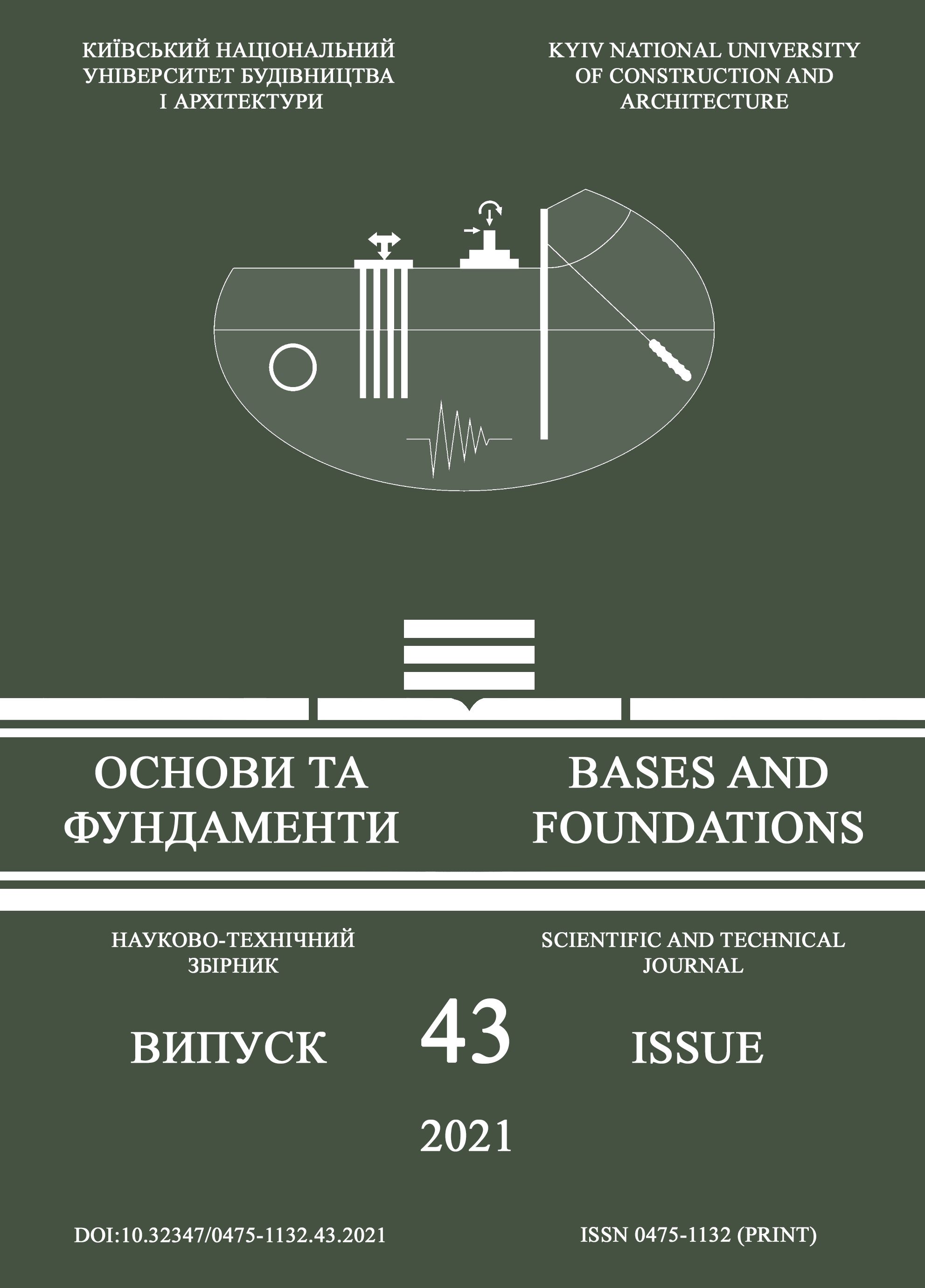Оцінка стійкості схилу з використанням різних розрахункових методів
Основний зміст сторінки статті
Анотація
В даній роботі представлено порівняння результатів оцінки стійкості схилу різними методами для визначення доцільності зведення протизсувних споруд та їх параметрів.
В якості об’єкту дослідження було обрано територію будівництва зернового терміналу на зсувному схилі в Одеській області. Нерівна ступінчаста поверхня схилу розбита розломами на блоки. Для забезпечення стійкості схилу планується влаштування каскаду протизсувних споруд – підпірних стін.
В основі проведених розрахунків лежить аналіз напружено-деформованого стану схилу та протизсувних споруд з використанням двох принципово різних методик розрахунків з використанням сучасних програмних комплексів:
- інженерна методика оцінки стійкості схилу (метод граничної рівноваги);
- числове моделювання напружено-деформованого стану (НДС) елементів системи «ґрунтовий масив – протизсувні конструкції – фундаменти споруди».
Розрахунки були виконані в межах двох розрахункових перерізів та для різних етапів забудови: 1-й етап – оцінка стійкості схилу в природному стані до початку будівельних робіт; 2-й етап – оцінка стійкості схилу на етапі влаштування підпірної стіни першого ярусу; 3-й етап – оцінка стійкості схилу після влаштування протизсувних споруд другого ярусу; 4-й етап – оцінка стійкості схилу на етапі експлуатації зернового терміналу, тобто з врахуванням влаштування фундаментних конструкцій комплексу та дії проектних навантажень. За результатами розрахунків було визначено коефіцієнти стійкості схилу, проведено аналіз НДС елементів системи «ґрунтовий масив – протизсувні споруди» та підібрано армування підпірних стін. Показано, що перевагою інженерного методу є простота його використання та також можливість визначити коефіцієнти стійкості. Проте даний метод не дає можливості отримати інформації про стан НДС в конструкціях протизсувних споруд та ґрунтовому масиві. Використання числового моделювання НДС елементів системи «ґрунтовий масив – протизсувні конструкції – фундаменти споруди» дозволяє оцінити стійкість зсувного схилу та отримати повну інформацію про зусилля і деформації в протизсувних конструкціях на різних етапах.
Блок інформації про статтю

Ця робота ліцензується відповідно до Creative Commons Attribution 4.0 International License.
Автори, які публікуються у цьому журналі, погоджуються з наступними умовами: Автори залишають за собою право на авторство своєї роботи та передають журналу право першої публікації цієї роботи на умовах ліцензії Creative Commons Attribution License, котра дозволяє іншим особам вільно розповсюджувати опубліковану роботу з обов'язковим посиланням на авторів оригінальної роботи та першу публікацію роботи у цьому журналі. Автори мають право укладати самостійні додаткові угоди щодо неексклюзивного розповсюдження роботи у тому вигляді, в якому вона була опублікована цим журналом (наприклад, розміщувати роботу в електронному сховищі установи або публікувати у складі монографії), за умови збереження посилання на першу публікацію роботи у цьому журналі. Політика журналу дозволяє і заохочує розміщення авторами в мережі Інтернет (наприклад, у сховищах установ або на особистих веб-сайтах) рукопису роботи, як до подання цього рукопису до редакції, так і під час його редакційного опрацювання, оскільки це сприяє виникненню продуктивної наукової дискусії та позитивно позначається на оперативності та динаміці цитування опублікованої роботи (див. The Effect of Open Access).Посилання
Schanz T. Zur Modellierung des mechanischen Verhaltens von Reibungsmaterialien. Mitt. Inst. für Geotechnik 45. Universität Stuttgart. Stuttgart, 1998. 152 p.
Kondner R. L. Hyperbolic stress strain response: Cohesive soils. Journal of the Soil Mechanics and Foundations Division, 1963. Vol. 89. Issue 1. pp. 115–144.
Duncan J. M., Chang C.-Y. Nonlinear analysis of stress and strain in soils. ASCE Journal of the Soil Mechanics and Foundations Divi-sion. 1970. № 96 (SM5). pp. 1629–1653.
Janbu N. Slope stability computation. Embankment-Dam Engineering. 1973. Casagtande volume. pp. 47–86.
Vermeer P.A., Brinkgrive R.B.J. Manual of Plaxis. Rotterdam, 2001.
Plaxis 2D 2015. Reference manual, Delft University of Technology & PLAXIS b.v., The Netherland, 424 p.
Schanz T., Vermeer P. A., Bonnier P. G. The Hardening Soil Model: Formulation and verification. Beyond 2000 in Computational Ge-otechnics. Balkema. Rotterdam. 1999, pp. 281–290.
Rowe P.W. The stress-dilatancy relation for static equilibrium of an assembly of particles in contact. Proceedings of the Royal Society of London. Series A, Mathematical and Physical Sciences. 1962. Vol. 269, No. 1339. pp. 500–527.
ДСТУ-Н Б В.2.1-31:2014. Настанова з проектування підпірних стін. К. : Мінрегіонбуд України, 2015.
ДБН В.1.1-46:2017. Інженерний захист територій, будівель і споруд від зсувів та обвалів. Основні положення. К.: Міністерство регіонального розвитку, будівництва та житлово комунального господарства України, 2017. – 43 с.
Schanz T. (1998). Zur Modellierung des mechanischen Verhaltens von Reibungsmaterialien. [On modeling the mechanical behavior of friction materials]. Mitt. Institute for Geotechnics 45. University of Stuttgart, 152 (in German)
Kondner R. L. (1963). Hyperbolic stress strain response: Cohesive soils. Journal of the Soil Mechanics and Foundations Division, Vol. 89. Issue, 115–144.
Duncan J. M., Chang C.-Y. (1970). Nonlinear analysis of stress and strain in soils. ASCE Journal of the Soil Mechanics and Foundations Division. № 96 (SM5), 1629–1653.
Janbu N. (1973). Slope stability computation. Embankment-Dam Engineering. Casagtande volume, 47–86.
Vermeer P.A., Brinkgrive R.B.J. (2001). Manual of Plaxis. Rotterdam.
Plaxis 2D (2015). Reference manual, Delft University of Technology & PLAXIS b.v., The Netherland, 424.
Schanz T., Vermeer P. A., Bonnier P. G. (1999). The Hardening Soil Model: Formulation and verification. Beyond 2000 in Computational Geotechnics. Balkema. Rotterdam, 281–290.
Rowe P.W. (1962). The stress-dilatancy relation for static equilibrium of an assembly of particles in contact. Proceedings of the Royal Society of London. Series A, Mathematical and Physical Sciences. Vol. 269, No. 1339, 500–527.
DSTU-N B B.2.1-31:2014. (2015). Nastanova z proektuvannya pidpirnykh stin [Guide-lines for the design of retaining walls]. K.: Ministry of Regional Development of Ukraine (in Ukrainian).
DBN V.1.1-46:2017. (2017). Inzhenernyi zakhyst terytorii, budivel i sporud vid zsuviv ta obvaliv. Osnovni polozhennia [En-gineering protection of territories, buildings and structures from landslides and land-slides. Substantive provisions]. K.: Ministerstvo rehionalnoho rozvytku, budivnytstva ta zhytlovokomunalnoho hospodarstva Ukrainy, 47 (in Ukrainian).
